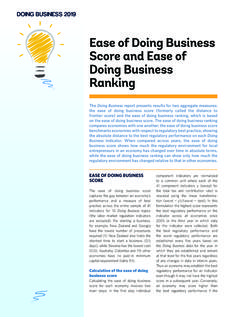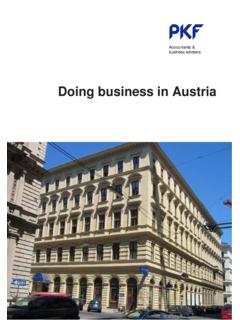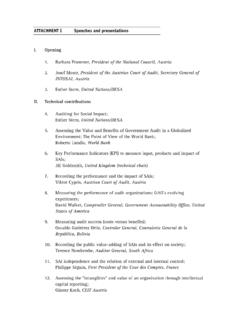Transcription of The Evolution Of The Airline Business Model - Austria
1 The Evolution Of The Airline Business ModelTechnology and Business solutions that give low-cost carriers the freedom to grow their businesses as they chooseLow-cost carriers (LCCs) have revolutionised the short-haul market, expanding the choice of air transport to consumers at the lowest cost. And they have done so by leveraging their cost efficiency and innovation to remain in a leading position, even in a disconcerting market. However, as the industry dynamics have changed, so have the Business strategies of LCCs. To compete for cost-conscious, short-haul passengers, many traditional full-service carriers created new products, restructured and streamlined their processes, slashed costs and aggressively priced many routes. As a result, LCCs were forced to change or enhance their Business models as well. 2 While price remains a key competitive factor, it is no longer the sole driver of low-cost carrier Business strategies. LCCs now focus on other areas, such as merchandising, multi-channel strategies and increasing partnerships.
2 They also place more emphasis on: Maintaining low costs while compensating for rising costs of fuel and aircraft, Integrating new services into the current Model and enhancing customer service, Crossing international borders and experimenting with long-haul segments, Expanding market opportunities such as increasing international reach and accessing the corporate segment by participating in a carriers veering from the fundamental low-cost strategy, it is no wonder that the low-cost Business Model has been difficult to define in recent years. The result of this shift is the emergence of the hybrid Business Model . This Model combines the cost-saving methodologies of a pure low-cost Airline with the service, flexibility and route structure of a full-service carrier. Figure 1 demonstrates this phenomenon of evolving models based on three 1 Characteristics of three hybrid Business models from 2008 to JetBlue Southwest Uses mix of narrow- and wide-body models Second quartile in cost performance Uses third-party aggregators Relationships with travel agencies/corporations Uses limited codesharing Facilitates interlining Differences by channel Uses private fares and restrictions Mix of short- and long-haul Inter-regional flights Sub-regional network; short-haul, point-to-point Offers same faresto all customers, handful of fares or interlining Direct sales onlyvia website Operates single aircraft Model ; topquartile in costs Inter-regional; connecting flights Differs fares by customer/channel; has restrictions Some use of codesharing and interlining Distributes through GDS Mix of aircraft models.
3 Mid-range cost performance Network Fare Structure Partnerships Sales and Distribution Operations Low-cost carrier Full-service carrier Business modelevolutionssngnshipel aFintennnvecosf lost- -haonellimarineorelNo codesharingUses mix of narrow- and wide-body models Second quartile in cost performance Uses third-party aggregators Relationships with travel agencies/corporations Uses limited codesharing Facilitates interlining Differences by channel Mix of short- and long-haul Inter-regional flights Sub-regional network; short-haul, point-to-point Offers same fares to all customers, handful of fares No codesharingor interlining Direct sales onlyvia website Operates single aircraft Model ; top quartile in costs Inter-regional; connecting flights Differs fares by customer/channel; has restrictionsSome use of codesharing and interlining Distributes through GDS Mix of aircraft models; mid-range costperformance Low-cost carrier Full-service carrier Business modelevolutionhoFaterlhshipnsvel acof sUsthiragUod locilrlistgiohtssharpshNetwork Fare Structure Partnerships Sales and Distribution Operations easyJet JetBlue Southwest fares and Uses private restrictions 4 Invest In Technology that helps your Business grow and sets you freeThe trend toward a hybrid Business Model impacts the requirements for IT systems and drives the need for a more sophisticated and flexible technology environment.
4 There are many reasons successful hybrid Airline executives invest in leading-edge technology with the right technology partner, such as: Moving to a new passenger service system (PSS) that supports the current Model as well as enables future capability requirements, Requiring technology to evolve and support the Airline s scale of Business , Requiring a provider with deep industry experience and sophisticated delivery methodology that meets current and future demands, Looking for greater revenue-producing codeshare and interline partnership opportunities, Expanding ancillary revenue, Identifying marketing opportunities to gain more accurate insight into customers behaviour patterns and , as a hybrid carrier, it is crucial to acquire technology that sets you free to focus on your changing Business the right technology, hybrid carriers can propel their businesses forward, responding more quickly and effectively to changes than ever Airline Solutions and Sabre Travel Network technology helps your Business evolve to the next level.
5 Sabre Travel Network connects sellers with travelers through the world s largest travel marketplace. Our Sabre AirCommerceTM solution bundles, powered by the Sabre system, deliver flexibility to meet your Airline s unique needs growing revenue, increasing reach and gaining valuable insight. In addition, by providing a portfolio of progressive solutions, Sabre Airline Solutions ensures that you are properly equipped to effectively and efficiently address future Business issues as they arise. No other company can provide technology with the same degree of flexibility to change and adapt as conditions demand. Based on service-oriented architecture, our Sabre ASxSM Airline Services Exchange gives you the flexibility to control, build and utilise your own in-house systems and/or third-party for airlines seeking a cost-effective alternative to an installed on-site system, our Software as a Service offering provides predictable, simplified pricing and equips airlines with an economical way to access our comprehensive portfolio of IT solutions without the usual added IT infrastructure.
6 With our SaaS offering you can: Significantly reduce total cost of ownership, Simplify your IT operations by letting us provide the right applications, hosting and maintenance, Focus on what you do best, namely managing passengers and flights, because we handle the IT environment, freeing up time and money for , more than 130 airlines benefit from more than 400 applications hosted by Sabre Airline technological foundation of our solutions portfolio delivers flexibility backed by years of industry experience, helping you to meet future challenges head Powerful Profitability Strategies with a complete marketing and planning solutionLow-cost carriers excel at streamlining operations and maintaining lower costs. However, to expand beyond the network and consequently increase the competitive landscape, a hybrid carrier needs to ensure that profit remains high. To do so, Airline assets (network, fleet) and revenue management strategies need to be optimised.
7 Our marketing and planning solution offers numerous profitability-gaining benefits including:Decreased revenue dilution and increased revenue The revenue management solutions you rely on must support the dynamic pricing environment of the hybrid carrier. Revenue benefits are realised through the support of restriction-free, low-fare ticket strategies, advanced forecasting and optimisation methodologies, accurate seasonality mapping and Business support for both market and route of processing modes You can run different processing modes based on the desired level of sophistication in inventory control, such as leg-and-segment-based serial nesting, O&D-based virtual nesting and O&D-based continuous competitor insight By considering competitor data from sources such as QL2, Infare or other third-party vendors during the analysis process, you can be confident of the revenue management decisions you addition, analysis of competitors Web data can assist with pricing and revenue management, such as using current data from competitors websites to determine whether making inventory modifications in response to their available fares is a sound Business decision.
8 6 Competitive revenue management Instead of using historical data maintained by the revenue accounting department, competitive revenue management helps you optimise the decision-making process by using data from the revenue optimisation tool. Integration between the revenue optimisation tool and the fare management tools enables your revenue management department to perform near real-time decisions, with the most relevant competitive insight. This integration also enables improved pricing actions. Provided with not only historical market trends but also current and dynamic information, you have access to future average fares, fare seasonality and even price sensitivity within the market. And with communication between external sources such as ATPCO and internal sources, such as a schedules analysis tool, your pricing analysts have access to data needed to publish the most competitive fares to support your Airline s position in the markets it serves.
9 Enhanced network planning You can more readily decide which markets to serve and how often, and when to fly and which type of aircraft you need to assign to a specific route. Plus, you can stay ahead of the competition through evaluation of the profitability of various scheduling alternatives and the opportunities provided by codeshare and network planning 2 Sabre AirVision Marketing & Planning key capabilities As an active Sabre AirVision Revenue Manager customer, we are enjoying the benefits of the solution. The recent measuring value report highlighted key metrics to our team. It is a great tool to help us to understand where we are doing well, and also where we need to focus and perhaps change some internal processes. We have observed increased productivity and good quality demand forecast. This helps our analyst make optimal decisions on managing our inventory. We are very happy with the support we receive from the Sabre [ Airline Solutions] team.
10 An Asian hybrid carrier7 Case StudySuccessful North American Carrier Chooses SabreSonic Customer Sales & Service To Help It GrowBackgroundA North American carrier that boards more than 20 million passengers per year selected the SabreSonic CSS solution to power its reservations, departure control functions, inventory and Internet booking carrier s previous reservations system offered limited ability to connect to and interact with other Airline reservations systems and GDSs. While the system supported the carrier s point-to-point route and manual processes for managing revenue and fares, it could not sustain the Airline s need to benefit from additional revenue sources by evolving its Business Model to include codeshare and interline partnerships opportunities. A more sophisticated solution was required to effectively support these TakenReasons for choosing SabreSonic CSS included: Improve revenues through codesharing and partnerships, Provide more flexible ancillary services sales and branded fares for higher up-selling capabilities, Guarantee an end-to-end customer view of its frequent flyer programme the carrier and Sabre Airline Solutions consider the cutover a success.





